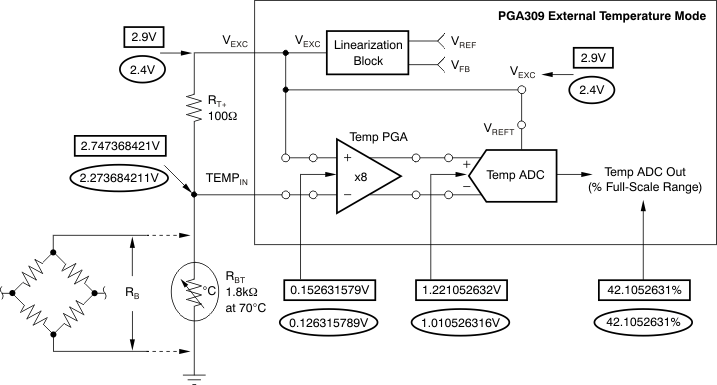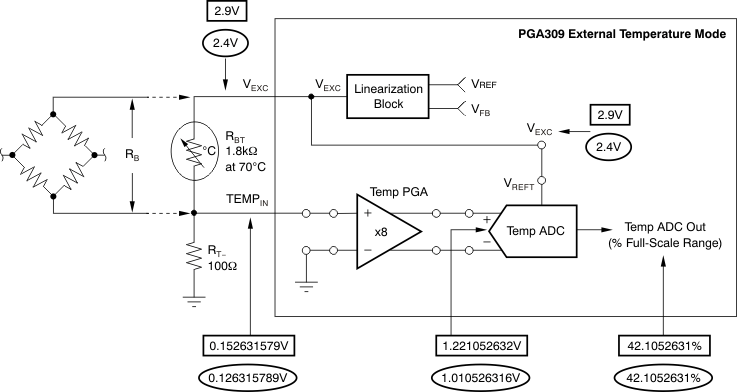SBOU024C august 2004 – july 2023 PGA309
- 1
- Read This First
-
1Introduction
- 1.1 PGA309 Functional Description
- 1.2 Sensor Error Adjustment Range
- 1.3 Gain Scaling
- 1.4 Offset Adjustment
- 1.5 Voltage Reference
- 1.6 Sensor Excitation and Linearization
- 1.7 ADC for Temperature Sensing
- 1.8 External EEPROM and Temperature Coefficients
- 1.9 Fault Monitor
- 1.10 Over-Scale and Under-Scale Limits
- 1.11 Power-Up and Normal Operation
- 1.12 Digital Interface
- 1.13 Pin Configuration
- 2Detailed Description
- 3Operating Modes
-
4Digital Interface
- 4.1 Description
- 4.2 Two-Wire Interface
- 4.3 One-Wire Interface
- 4.4 One-Wire Interface Timeout
- 4.5 One-Wire Interface Timing Considerations
- 4.6 Two-Wire Access to External EEPROM
- 4.7 One-Wire Interface Initiated Two-Wire EEPROM Transactions
- 4.8 PGA309 Stand-Alone Mode and Two-Wire Transactions
- 4.9 PGA309 Two-Wire Bus Master Operation and Bus Sharing Considerations
- 4.10 One-Wire Operation with PRG Connected to VOUT
- 4.11 Four-Wire Modules and One-Wire Interface (PRG)
- 5Application Background
-
6Register Descriptions
- 6.1 Internal Register Overview
- 6.2
Internal Register Map
- 6.2.1 Register 0: Temp ADC Output Register (Read Only, Address Pointer = 00000)
- 6.2.2 Register 1: Fine Offset Adjust (Zero DAC) Register (Read/Write, Address Pointer = 00001)
- 6.2.3 Register 2: Fine Gain Adjust (Gain DAC) Register (Read/Write, Address Pointer = 00010)
- 6.2.4 Register 3: Reference Control and Linearization Register (Read/Write, Address Pointer = 00011)
- 6.2.5 Register 4: PGA Coarse Offset Adjust and Gain Select/Output Amplifier Gain Select Register (Read/Write, Address Pointer = 00100)
- 6.2.6 Register 5: PGA Configuration and Over/Under-Scale Limit Register (Read/Write, Address Pointer = 00101)
- 6.2.7 Register 6: Temp ADC Control Register (Read/Write, Address Pointer = 00110)
- 6.2.8 Register 7: Output Enable Counter Control Register (Read/Write, Address Pointer = 00111)
- 6.2.9 Register 8: Alarm Status Register (Read Only, Address Pointer = 01000)
- A External EEPROM Example
- B Detailed Block Diagram
- C Glossary
- Revision History
2.7.2 External Temperature Sensing with an Excitation Series Resistor
Some bridge sensor applications measure the temperature of the bridge sensor by the change in the bridge resistance. This is accomplished by adding a series resistor in either the top or the bottom of the bridge excitation connections. When this is done, the common-mode voltage range of the PGA309 inputs must be observed over the operating temperature range of the application.
Figure 2-20 shows a top-side series resistor (RT+) used to monitor the change in bridge resistance with temperature. For simplification of analysis, the effective bridge resistance is converted to one resistor (RBT), as shown. For a given temperature, RBT will be a fixed value; for this example, 1.8kΩ at 70°C. Since RT has a negligible change in temperature (50ppm/°C) compared with RBT (3500ppm/°C), RT is used to detect a change in RBT. For this application, the Temp PGA is configured for VEXC on the +input, and TEMPIN on the –input. The Temp ADC uses VEXC as its reference, VREFT. The Temp PGA is set to a gain of 8. Notice that two different values for VEXC will be analyzed to emulate the changing voltage on VEXC due to the linearization block adjusting VEXC to minimize error on the bridge sensor output with applied pressure. The squareboxed values show numerical results for VEXC = 2.9V and the oval-ringed values for VEXC = 2.4V. The final Temp ADC reading will be the same value regardless of what value VEXC is used by the linearization block.
Figure 2-21 shows a bottom-side series resistor (RT−) used to monitor the change in bridge resistance with temperature. Again, for simplification of analysis, the effective bridge resistance is converted to one resistor (RBT) as shown. For 70°C, RBT is 1.8kΩ for this example. RT is used to measure the change in RBT. The Temp PGA is configured for TEMPIN on the +input and GND on the –input. VEXC is selected as the Temp ADC reference, VREFT. The PGA gain is 8. The square-boxed values are results for VEXC = 2.9V and the oval-ringed values for VEXC = 2.4V. It is seen that the final Temp ADC reading will be the same regardless of the VEXC value.
If the linearization block is not used in the application, the bridge sensor top excitation connection is made to either VSA or VREF, instead of VEXC. In either of these cases, top-side (Figure 2-20) or bottom-side (Figure 2-21), external temperature sensing can be done by adding a series resistor, RT. The Temp ADC reference (VREFT) should be changed to the bridge excitation voltage (VSA or VREF) for the specific application. This yields a constant Temp ADC output at a given temperature independent of changes in the bridge excitation voltage.
 Figure 2-20 External Temperature Sensing of Bridge Sensor with Top-Side Series Resistor
Figure 2-20 External Temperature Sensing of Bridge Sensor with Top-Side Series Resistor Figure 2-21 External Temperature Sensing of Bridge Sensor with Bottom-Side Series Resistor
Figure 2-21 External Temperature Sensing of Bridge Sensor with Bottom-Side Series Resistor